

On the third night at the house—the sixth day of shooting—it was time to film the first stunt sequence. In order to make the most of the stunt scenes, two cameras were filming at the same time from different angles. This would mean there had to be virtually two camera crews. And the bedroom had already been crowded before.

The stunt crew arrived and started looking the house over to get a grasp of what would be expected. They would be doing the lesser of the two stunts on this particular night, but they were already eyeing the spot for the big stunt that would be shot the next day.

The stuntman wanted to do both stunts in one night, but Jon explained they would need to do one each night to give the camera and lighting crews plenty of time to set up for each stunt.
One of the actors was going to be late, so they had to rearrange the shot list. Jon blocked the scene while the crew got set up in the bedroom. They would be doing a wide shot with the actors and a closer shot with the stunt doubles.
Although Chip was the stuntman, there were a total of three stunt people—Chip, another guy and a girl. Chip is also a director with a strong personality and Jon made sure right away there would be no conflict of ideas. He emphasized what he was looking for as the director and Chip went with it.

Jon (director), Libby (cinematographer), Andy, (1st assistant director) and Jeff (sound / film editor) discussed the stunt shots. For some of these filmmakers, this would be the first time they had ever filmed a stunt. Things went really well and they got some great takes—even an extra unscheduled shot to add a little more violence. They got their first shot around 9:00.

In a regular scene, the director will make sure to not “break the line.” This means avoiding positioning the camera at an angle that disorients the audience—for instance going to the opposite side of a table conversation. This would disorient the audience making them automatically think for a moment the characters have “switched sides.” However, when doing a stunt sequence, the director will intentionally “break the line” so that the audience is disoriented by design, adding to the energy of the sequence.

Jon talked about the balance of quantity vs. quality. There’s a balance between tweaking a shot forever and getting the shot. We talked about “a mediocre something is better than a perfect nothing.”
On the average, there were about 12 to 15 shots each night. Some of them had $$ next to them and others had ** next to them. The first were the “money shots”—ones that were crucial. The two asterisks meant the shot could be sacrificed for the sake of time if necessary.
Dream shots were saved for last—only done if there was extra time. Although they were not crucial, if time allowed, it would be cool to get them.

There was a tap for Camera A and a tap for Camera B. During the stunts, Jon watched one tap while Jeff (his editor) watched the other to make sure they got what they wanted.
To test the look of the blood, the makeup artist put different shades of blood on her hand and held them out in the light for Jon to see. He looked them over and made his choice, like someone picking out a tie.

Time started moving faster than the shot list. Jon’s hair was up by 10:30.
Several times, Andy and Jeff provided editing insight for Jon. He knew what he was looking for, but he also knew how to use the skills of the people around him.

Four people unexpectedly showed up at the shoot. They were considering attending Chapman and somehow had found out about Jon’s film. This was kind of weird since Jon didn’t know how they found out about it or how they got here. The house is located in a gated community and you need a code to get in.

When the stunt shots were finished, Camera B crew wasn’t needed any longer, so they packed up and went home. This of course gave Camera A crew the opportunity to make fun of them for being wimps since they went home before dawn.

Up until their senior year, most students at Chapman are used to shoots that last four to five days. This was a ten-day shoot, so it was starting to show that this was a longer haul than most of them were used to. On top of that, the majority of this film was mostly being shot all night for several nights in a row.

A large number of thesis films are notoriously “kitchen sink dramas,” in which various dysfunctional relationships are put on a slow and painful parade. This are often cliché and forgettable.

Sometimes a student will attempt a comedy. But comedy either works or it doesn’t. And most of the time, in this arena, it doesn’t. For a thesis film, falling flat in this respect is bad.
Suspense in a thesis film is relatively rare. Some Chapman suspense films have gone on to gain significant attention.

Around 3 a.m. another stunt was done, involving a rice pack strapped to the stuntman’s shoulder. More blood. Cool.

During one of the shot’s the camera could clearly see the stunt girl’s face. She offered to “action hair it,” by intentionally letting her hair fall across her face.
At lunch, I learned a little more about film making etiquette from Andy. There are established rules as far as the order of who goes through the line at lunch. Talent goes first. Then the camera crew. And so on, until the first assistant director (Andy) goes last. That’s the rules.
After lunch, it was back to work.

One thing that is noticeable about Jon’s style of directing is subtlety. He is all about underplaying the camera moves, almost to the point they will be mostly subconscious to the audience. He shows a true professionalism in his choices.

It’s a lot like when somebody is first trying to write fiction. They use too many adjectives and they dig words out of a thesaurus they’ve never used in their life in order to sound like a writer. The more they try to sound like a writer, the less they sound like a writer. The first rule of cool: if you try to be cool, you are in fact, not cool.

Good film making, in the same way, is about making it look effortless. In other words, making it look like is wasn’t directed. And such effortlessness requires a lot of effort. Jon has a delicate touch with his filming and each shot has an impressive natural look that simply tells the story and it is extremely effective.

Still behind schedule, Jon decided to move some of the Thursday shots to Friday.
As the night started drawing to a close, the camera and the dolly were placed in the bathroom leading into the bedroom. The final shots for the night would take place here.

The last shot of a day’s work of filming is called the Martini Shot. The one just before is called the Abby Singer Shot (because there was a director of that name who would always think she was on the Martini Shot, but was actually on the one just before it).
They completed the Abby Singer Shot and then set up for the Martini Shot.

It was 5:30. Thirty minutes to go. They changed mags (the roll of film) to finish off one more take of the Abby Singer Shot, then set up for the last one.
The tap was in the bathroom. Jon, Andy, the script supervisor and makeup were all in there, Andy making use of the tub. Jon noticed Andy’s eyes were closed and said, “Now, Andy. None of that.”
Andy opened his eyes. “I was just visualizing the next shot.”

At 5:45, they started shooting the Martini Shot. Jon wanted a slow pull back, but the bathroom floor tile made the move a little bumpy. Andy said they’d probably be able to fix that in postproduction.
This was also the night the very last shot of the movie was filmed. They had a beginning and an end now. The remaining two days would be a lot of work to fill in the rest.




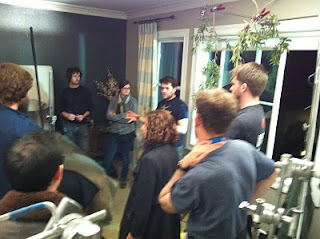
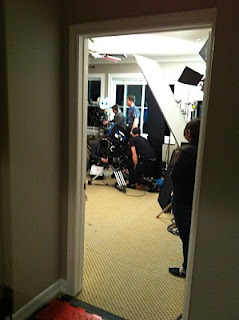



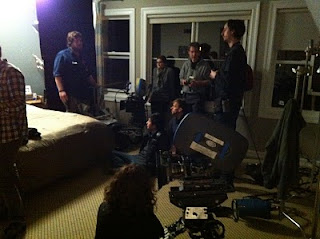

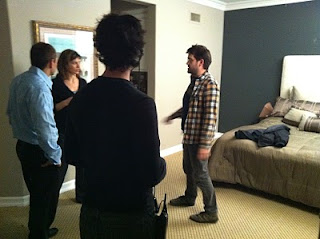








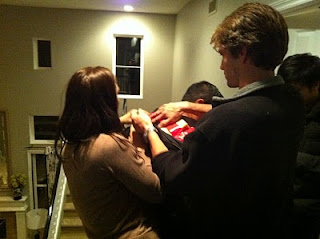

























1 comment:
http://dl3mashael.blogspot.com/2011/02/life-after-death-zycie-po-smierci.html
Post a Comment